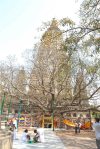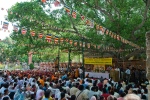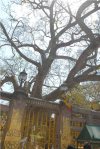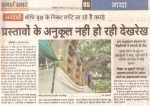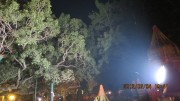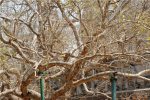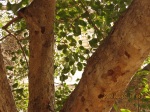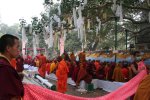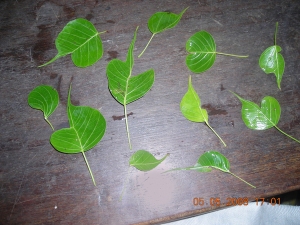REPORT OF THE MAGADH DIVISION COMMISSIONER
CONFIDENTIAL Letter No. 422 / C Dated 1.12.2007
SEALD COVER
To
The Chief Judicial Magistrate
Gaya.
Reference :- Your letter No. 198 / 27.08.2007 and 2329 / 16.10.2007 dated appertaining to complaint case no. 850 / 2007 Arup Bramhachari Vs Jitendra Srivastav & others to investigate and report relating to the matter in issue.
Sub:- Enquiry report of the matter under reference.
Sir, I have personally enquired on 5.11.2007 and probed about the correctness of the complaint under reference and found the truth as follows :-
1. It is true that the Bodhgaya Temple Management Committee ( B.T.M.C ) is entrusted with the management and control of Bodhgaya Main Temple, Temple land and the properties appertaining thereto under the Bodhgya Temple Act and as such B.T.M.C has absolute control over the same and no one can do any thing the same without knowledge and permission of B.T.M.C
2. The persons arrayed as accused in the complaint case under reference are the members and authorities of B.T.M.C
3. The Great Holy Pipal Tree is of immense archaeological, religious, national, international and social importance and among others the same has also been declared as “ World Heritage ” by the “ UNESCO”. Hence, the great Pipal tree is public property.
4. On enquiry it transpired to me by the witnesses viz. Deepak Malaker and Ajay Paswan that on 10. 07. 2007 the accused no. 3 Bhante BodhiPal, ordered Sri Deepak Malaker, working as employee of B.T.M.C at that time, to cut down some cardinal parts of the great Pipal tree and in obedience of the dictation of his master the said Sri Deepak Malaker cut down the same in presence of the accused no. 4 Sri Bhajju Yadav. After getting cut down some substantial parts of the great Pipal tree, the said accused Bhante Bodhipal ordered the said Sri Deepak Malaker to carry the same to his house i.e B.T.M.C compound area and accordingly Sri Deepak Malaker carried the cut down piece of the great Pipal Tree to the house i.e B.T.M.C compound area of the said accused Bhante BodhiPal.
5. I have seen the Cut Off portion of the great Pipal Tree personally and it appeared to me that the cuttings are about 2 years old from now. The “ Forest Research Institute ” of Dehradun also conformed about the cutting down the Holy Pipal Tree.
6. However, the main control over the “Temple’s ” properties and the great Pipal Tree has been of the accused no. 2 to 4 as they have / had direct links with the day to day affairs of the same. The accused no. 1, being merely an Ex – Officio Chairman of B.T.M.C is honoured with only ornamental post to whom no direct liability should be charged.
7. At the time of enquiry I also found that the great Pipal Tree leaves collected by their special staff at the time of spring and then sold it to the special friends by the culprits through their high voltage technique. Not only that there are lot of monetary scandal done by the accused no. 2 and 3 which must be checked by the special audit and judicial enquiry may be conducted to know the nefarious activities going on in the Temple area and B.T.M.C.
8. Hence, in conclusion, I myself find that the accused no.2 Dr. kalicharan Yadav, 3. Bhante BodhiPal, 4. Bhajju Yadav ( P.R.O ) are involved in some nefarious activities like cutting the branches of the great Pipal Tree, not maintaining any log book which is mandatory to touch the great Pipal Tree. There are no accounts for the leaves they take out from the Tree or are collected. Cutting of branches of the great Pipal Tree have been done casually which even a common man would have not been down it. These people exploiting the “ Temple Area ” and the properties of the B.T.M.C to gain their personal advantages which is related to monetary affairs and a high powered team of expert must investigate the personal wealth of accused no. 2 to 4. Therefore the complaint case under reference is true and correct against no. 2 to 4 and hence accordingly apt and suitable legal action should be taken against all of them.
COMMISSIONER
Magadh Division
Gaya, Bihar
ORDER OF THE HONOURABLE HIGH COURT OF PATNA
IN THE HIGH COURT OF JUDICATURE AT PATNA
CWJC NO. 1565 of 2008-08-30
ARUP BRAMHACHARI @ SWAMI JI Versus THE UNION OF INDIA & OTHERS
Serial No. of Order – 02 Date : 3. 03. 2008
Grievance of the petitioner in the present writ application filed Public Interest Litigation is regarding mismanagement of the fund of Mahabodhi Temple and its mal-administration.
Having heard Mrs. Rina Sinha, for the petitioner, Mr. Sarvdeo Singh, for the Union of India and taking into consideration the facts and circumstances of the case, we are of the opinion that the petitioner shall be well advised to raise his grievance before the State Government.
Needless to state that in case such a grievance is raised the State Government shall consider the same in accordance with law.
However, we make it clear that we have not expressed any opinion in regard to the claim made by the petitioner.
Application stands dismissed with the observation aforesaid.
Sd /- CHANDRAMAULI KUMAR PRASAD, A.C. JUSTICE
Sd /- JAYANANDAN SINGH, JUSTICE
NOTE : JUST THINK FOR A MOMENT AFTER READING THE ABOVE JUDGEMENT THAT IS WHEN A PERSON GO TO COURT ? WHEN THE OFFICERS DON’T LISTEN THE PUBLIC GRIEVANCES THEN A PERSON IN THE COURT. THEN HOW A ACTING CHIEF JUSTICE CHANDRAMAULI KUMAR PRASAD CAN SAY ” GO TO STATE GOVERNMENT ” !!! ??? IN BIHAR EVERY THING IS POSSIBLE, EVERY WHERE FIXING !!!!!!!!!!
IMPORTANCE OF BODHI TREE
BY LINDA NOBLE, USA
Abstract
“……. In a world of growing state and gang violence with western militarism ( lead by an egotistical, paranoid and short sighted leader of the USA ) against a ” war on terror ” which can not be won ( and only produces suffering for millions of innocent non-combatants ), wisdom, compassion and peaceful diplomacy is the only rational and practical way to save future generations of this world.
A young Indian aesthetic started the peaceful inner revolution of the human mind, ( which is a counter force to militarism and violence ) 2500 years ago when he became enlightened under a simple Bodhi Tree. The teaching of the Buddha are very applicable today and the Bodhi Tree is ” THE PEACE SYMBOL ” of out changing world, for now and the future. Since Indian civilization is renound for philosophy, religious and cultural diversity, and is aloe the largest demarcation nation in Asia, India now has the moral obligation to be the custodian of the tree for all people of the world.
Now in our age of globalisation, the Buddhist philosophy of interdependence and the doctrine of emptiness are even more visible and applicable. Understanding this ancient Indian philosophy is not only gaining popularity but is being accepted by the greatest of political, scientific mind of our time. With His Holiness the Dalai Lama, a Nobel Peace Prize Laurent and refugee who is eternally grateful to India, as a world representative for Indian Buddhist Philosophy and proponent of Mahatma Gandhi’s peaceful politics and means, India has such a fantastic opportunity to become a strong voice in the world stage of peacemaking . And the symbol for world peace is the Bodhi Tree. Saving the tree is a statement that says peace is not only possible but absolutely necessary in a fast changing and desirous world. Save the symbol of Ancient Indian Philosophy that can help the world find answers on the path to peace. ….. ”
FIRST SCIENTIST REPORT OF HOLY BODHI TREE
BY
DEHRADUN FOREST RESEARCH INSTITUTE
Observations on The Bodhivrikhsa ( Ficus Religiosa ) at Bodhgaya
As requested by the District Magistrate, Gaya a team from Forest Research Institute, Dehradun comprising following scientists visited the Bodhgaya Temple on 28th June 2007 :
1. Dr. N.S.K. Harsh, Tree Pathologist
2. Dr. Subhash Nautiyal, Tree Physiolgist
3. Shir Ram Lal, Wood Scientist
Observations
The revered tree Bodhivrikhsa ( Ficus religiousa ), the papal tree was closely examined and inspected by the team and following observations are made.
1. The tree is growing normally but major growth is towards one side only while on the other side is temple structure. The branches were spreading towards one side away from the temple.
2. Just at the base of the tree is the seat of enlightenment ( Bajresan ) on one side towards the temple.
3. Around the base of the tree the soil was open, upto 3meters in rectangular shape.
4. There were dead and dying branches present on the tree. Few branches stubs and wounds of previous cuts were also observed.
5. The main tree is surrounded by a small-cemented wall and metallic grill.
6. The small cemented wall surrounding the tree has now been pierced by the roots and has cracked.
7. Some of the new roots and bark at the base were dying. Some of the roots were exposed on the moil surface.
8. The stem, bark and exposed wounds were painted with Bordeaux ( copper sulphate, lime and water ) paste as told by Dr. A.K. Singh, Scientist from Rajendra Agriculture University, Patna.
9. The branches were supported by iron pillars used as props.
10. Two open surfaces were being used for providing irrigation to the tree outside the main structure. At present they appeared to be having excess water.
11. Mealy bug attack was also observed on one of the twigs. It was told that there is regular attack of mealy bugs on this and other papal trees in the campus
12. One dead and decaying branch stub was present near the base ( above 1.5 meters approx. ) on the southwest side, which on tapping gave a hollow sound towards the basal end of the branch suggesting progress of heart rot disease ( hollowness ). Isolation were made from the decaying part of the stub for associated fungi and other micro-organisms.
13. Test for hollowness was also conducted all around the main stem by tapping for sound echoes, which reveled absence of heart rot in the trunk at present.
14. The cut portion of the branch, which has given rise to the present controversy, was closely inspected. The cut branch is nearly 20feet above the ground. On examination the cut end revealed following features :-
a. Radial as well as longitudinal cracks on the cut surface.
b. Absence of bark up to 3 feet from the top towards the trunk
c. Bleached of advance decay of white fibrous rot type.
d. Bordeaux paste was also applied on the cut end earlier as informed by Dr. A.K. Singh.
e. The coppice shoots have come out from the lower end where bark was present.
15. Two other trees of pipal, which were nearby to the Bodhivriksha were also examined. Both the tree showing good vigorous healthy growth, even better then Bodhivriksha. It was informed that during May this year there was premature leaf full of new leaves on the Bodhivriksha, which may be due to some acute physiological stresses affecting the tree. The papal tree on the left of the Bodhivriksha has entrapped the broken cemented wall structure made earlier for boundary by the growing roots of the tree. The tree on the right of the Bodhivriksha was seen wrapped with a yellow cloth around its trunk, which when removed showed termite and fungal attack on the bark of the tree.
16. The metallic props created for the support of the branches were noticed causing injury to the bark and tissue, which can be seen as dropping of latex on the props.
17. There was lighting arrangement of the Bodhivriksha in the night. The intensity of the light and heat generated to the nearby branches by the lamp shades, reflectors and bulbs installed may be causing damage to the tree.
18. No other vegetation was noticed growing below the Bodhivriksha tree.
19. The moisture content was observed on various parts of the tree for examination of the status of stress. The data is being analyzed.
20. The samples of wood, bark, leaves and soil were collected for laboratory studies
Inferences drawn about Bodhivriksha
It can be suggested that the Bodhivriksha has recently undergone some form of stress, which was being reflected by the some what scanty and light green leaves in the canopy and damaged roots and bark, as compared to the other two pipal trees growing nearby. The possible reasons for the stress could be :
a. The light green colour of the leaves may be due to their being new flush and as the leaves are tender.
b. Copper toxicity due to repeated application of Bordeaux paste on the stem and branches as informed.
c. Excess moisture in the soil causing asphyxiation ( suffocation ) of the roots as observed in the near by – irrigated areas.
d. Heat injury due to reflection of solar radiation from the temple structure, which is quite close to the tree.
e. High intensity electric lights causing hindrance to the respiration process in the night.
f. The soil was devoid of any other vegetation suggesting an unfavorable environment for the growth of plants, may be due to some heavy metal toxicity.
g. Soil compaction due to trampling under human feet.
h. It appears that aging of the tree is slowing down the physiological processes.
Inferences drawn about the cut branch under reference
The stump of the branch was carefully and erratically examined visually and it appears that the cut is more than three years old. The basis of this prediction is explained below.
1. When a cut or wound is made on a live tree, the sap comes out which is rich in carbohydrates; the sap turns brownish due to the exposure to light and oxygen imparting darker colour to the exposed surface.
2. The exposed wound is colonized by micro-organisms like bacteria and yeasts.
3. The exposed surface develop callus and new shoots emerge below the cut.
4. Weathering of the exposed surface takes place over the time giving bleached appearance to the exposed surface.
5. Decay fungi set in causing rotting of wood on the dead surface, which may extend to the heartwood establishing heart rot, which gradually create hollowness. The fruiting bodies of the decay fungi then appear on the exposed surface.
6. The whole processes may take time well over one year but in drier localities with higher temperature this period may be even more than that.
7. The branch under reference exhibited bleached appearance and decay suggesting it was exposed ( cut ) more than three years ago.
8. The absence of callus formation, debarking, absence of fruiting bodies of fungi and presence of radial and longitudinal cracks can be attribute to the heat generated by an electric lamp ( top being metallic ) present just below the cut branch which was lighted in the nights. The heat generated gradually causing seasoning ( drying ) of wood revealed as radial and longitudinal cracks on the exposed surface and splitting and falling of bark. The lamp post was moved after March 2006. Moreover, the treatment with Bordeaux paste had also attributed to the debarking, absence of callus and fungal fruiting bodies.
9. These observations were also corroborated by the photographs provided by the committee, showing date as November 2004 and March 2006 in banners present in the photographs. The cut branch is visible well above the lamppost in these photographs thus confirming the inferences drawn by our study.
10. The Institute does not have any methodology to precisely determine and predict the time and period of cutting of a tree or its branch, therefore, the predictions made in the present study are suggestive.
Immediate Steps to be taken for restoration of health for the Bodhivirksha
The declining health of the Bodhivriksha can be restore by adopting following measure :-
1. The application of Bordeaux paste should be immediately stopped
2. Excess water in the areas meant for irrigating the tree should be regulated.
3. The cemented wall near the base should be removed. Care should be taken not to damage the roots underneath it.
4. The exposed roots should be covered with soil.
5. Dead branches to be pruned carefully. Small branches may be flush cut initially, but the weight of the branch should be supported until it is completely severed to avoid tearing of the bark below the wound.
6. The exposed wounds and cut ends should be given dressing with 1 % Bayleton ( Tridemefon ) in linseed oil with a paintbrush to cheek the infection and spread by decay fungi.
7. Any operation being done for the care and maintenance of the tree should be displayed at a proper place to inform people and for transparency to avoid any controversy.
8. Between the props and branches thick packing of polyurethane foam should be inserted for cushioning and avoid injury the bark and tissues.
9. For the management of infestation by mealy bug, spray with 0.02 % Dimethoate should be done on the affected branches with few drops of liquid soap ( shampoo ) as sticker. As the females of the insect crawl from ground on the stern, sticky bands about one meter above ground would cheek their climbing up.
10. The people should be stopped from going near the tree to avoid soil compaction by trampling.
11. The metal halide lamps and other lights, which are closed to the tree should be removed. If light of the tree is necessary, it should be done from a distance with low intensity bulbs, preferably focusing from ground fixtures.
12. The entrapped cement wall piece by the roots of other pipal tree should be carefully removed without damaging the roots.
13. Wrapping of trees with cloths should be avoided.
14. Burning of oil lamps and incense sticks should not be allowed to avoid injury to the roots and stem of the trees.
15. The wooden support and frame around one of the bells ( 2550 kg ) has started showing weathering and decay and needs preservative treatment to be provided by FRI, Dehradun.
Future Course of Action
A memorandum of understanding would be drawn out between the Bodhgaya Temple Management Committee, Bodhgaya and Forest Research Institute, Dehradun for future management and upkeep of the Bodhivriksha in particular and other trees in the campus in general, besides beautification of the campus with suitable plant species. A suitable consultancy project would be developed by Forest Research Institute, Dehradun for this purpose.
Ram Lal Dr. Subhash Nautiyal Dr. N.S.K. Harsh
Wood Scientist Tree Physiologist Forest Pathologist
WASHINGTON POST REPORT
SCANDAL GNAWS AT BUDDHA’S HOLY TREE IN INDIA
By Simon Denver, Reuters, February 3, 2008
DEATH THREATS
Its central stupa rising 187 feet above the ground where Siddhartha Gautama is said to have become the “Awakened One,” the temple is thought to have been built 1,500 years ago and was declared a UNESCO World Heritage Site in 2002. Inside, in front of a giant golden statue of Buddha, pilgrims from Japan, Sri Lanka, China, Thailand and the West kneel and chant. Outside, others collect fallen leaves from the giant tree and others growing in the temple courtyard.
Clad in white robes, the barefoot and bearded Brahmachari excitedly points out the spot where the branch was chopped off, as well as empty niches around the temple grounds where he says statuettes of Buddha stood until recently.
“They sent the branch to Thailand, and sold it for 6 crore (60 million) rupees ($1.5 million),” he said, adding he had been beaten up twice and had received several death threats since starting his campaign.
The government, he said, was simply not interested. “Nobody is listening. I am fed up of writing letters.” But he is not alone in his anger, joined by Buddhist priests running many of the other temples and monasteries which have sprung up in Bodh Gaya.
Although its accounts are audited, the priests complain the temple does nothing to support local schools and hospitals, despite having a substantial income. “Money is coming in, but where the money is going nobody knows,” said Bhante Pragyadeep, treasurer of the Buddhist Monks Association of India.
District magistrate Jitendra Srivastava has been running the temple committee since the scandal surfaced and the last committee’s term expired. “All secretaries have been embroiled in controversy,” he said. “It is very unfortunate.” Significant amounts of money had been spent “beautifying the temple and giving it world-class facilities,” he said, and no allegations of corruption had surfaced since he took over.
While the charge of cutting a branch was now sub judice, allegations of deeper wrongdoing had not been substantiated. “A lot of people say this but I have no credible evidence. It remains to be seen if these people have taken this money.” Meanwhile, many Buddhist priests say they, and not Hindus, should be running one of the holiest sites in their religion.
But magistrate Srivastava said that would be no guarantee of honesty in the future. “A thief can be a Hindu or a Buddhist,” he said. “A thief is a thief, he has no religion.”
( Editing by Mark Williams and Megan Goldin )

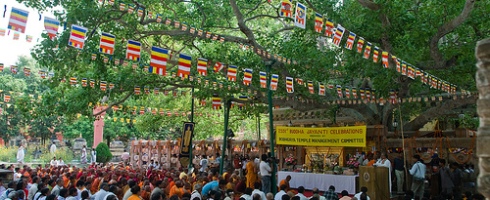
![DSC_2389[1]](https://swamiji1.files.wordpress.com/2012/04/dsc_23891.jpg?w=150&h=100)

